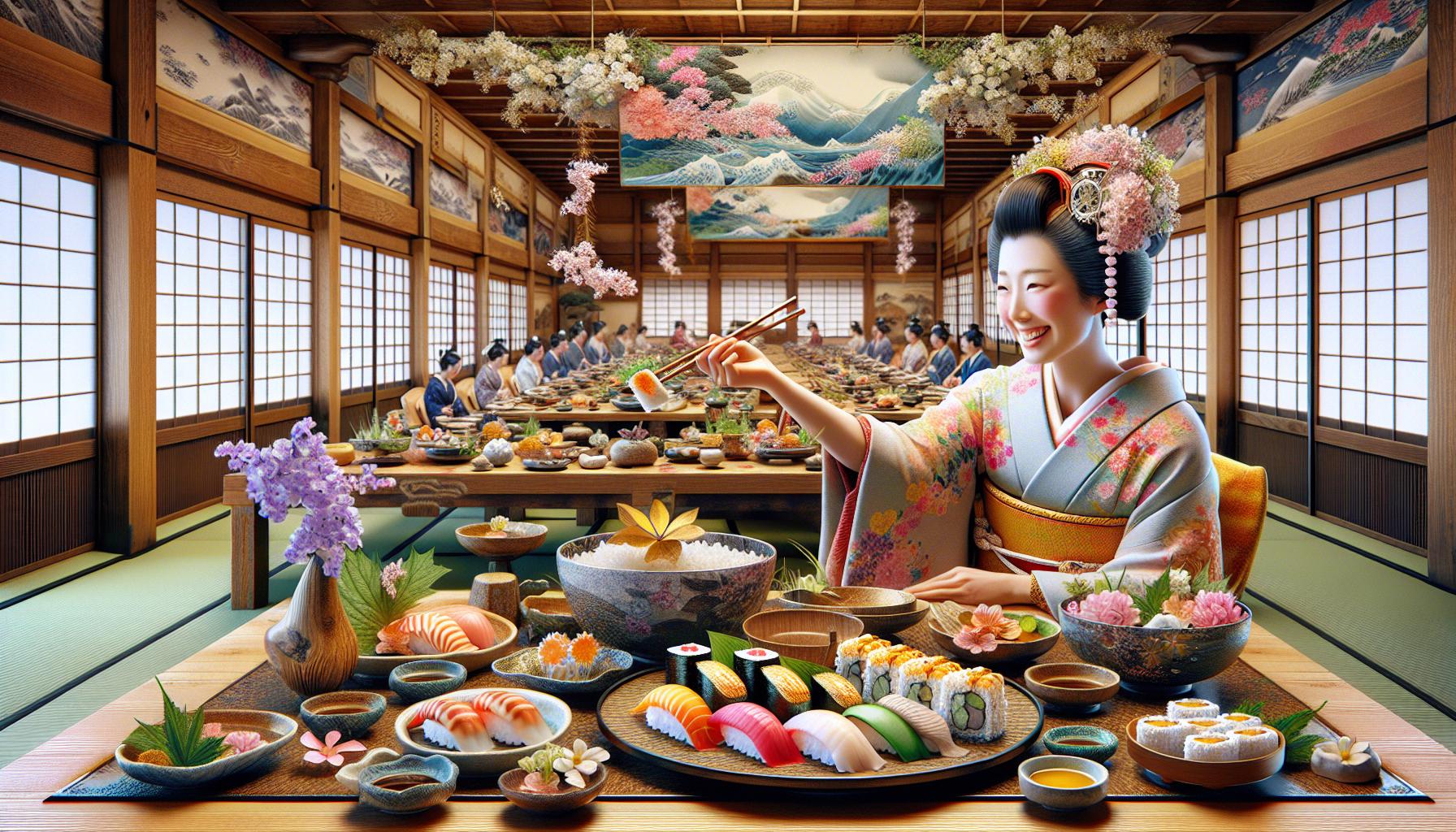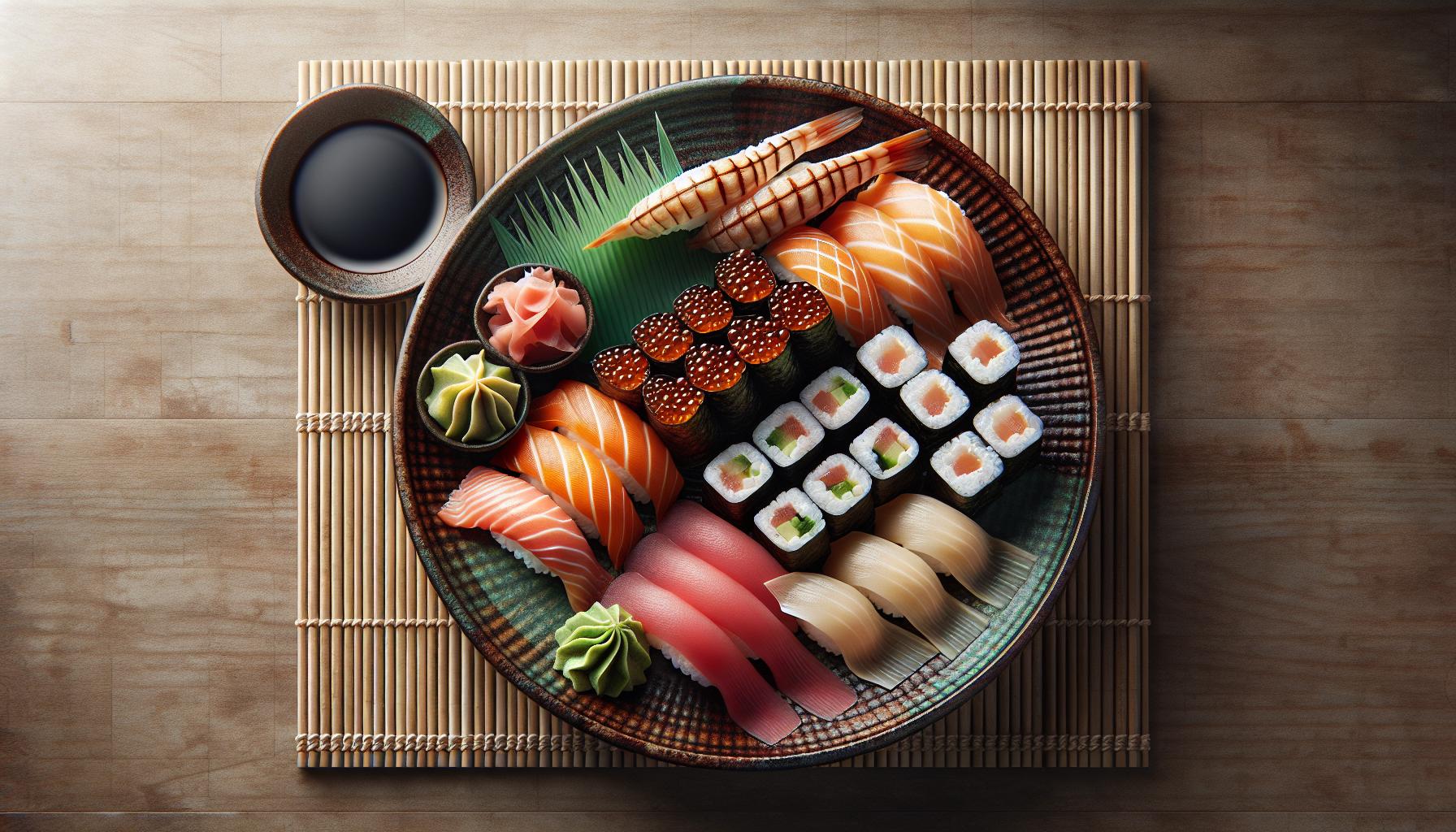Physical Address
304 North Cardinal St.
Dorchester Center, MA 02124

Japanese cuisine has evolved into more than just a way to satisfy hunger – it’s a mesmerizing blend of art tradition and flavors that captivates food lovers worldwide. From the precise knife cuts of sashimi to the mindful arrangement of bento boxes this culinary culture reflects centuries of refinement and respect for ingredients.
At the heart of Japanese food culture lies the concept of “washoku” – a UNESCO-recognized dietary philosophy that emphasizes seasonal ingredients balance and aesthetics. It’s not just about what’s on the plate; it’s about creating harmony between food presentation and nature. Modern Japanese dining continues to honor these age-old principles while embracing contemporary innovations making it one of the world’s most influential and respected cuisines.
Japanese food philosophy centers on achieving harmony between taste, texture, and visual presentation while maintaining deep respect for natural ingredients. This holistic approach integrates spiritual elements with practical cooking methods.
Washoku represents the foundation of Japanese culinary traditions, emphasizing five key elements: color, taste, preparation methods, sense, and spiritual outlook. The color principle incorporates five specific hues in meals: red, yellow, green, black, and white. Each dish balances five distinct flavors: sweet, sour, salty, bitter, and umami. Traditional preparation techniques include raw, simmered, grilled, steamed, and fried methods. The sense aspect focuses on the use of proper dishware to enhance the dining experience. The spiritual component connects food to nature through seasonal ingredients and mindful preparation.
Japanese cuisine follows the concept of “shun,” which identifies the peak season for each ingredient’s optimal flavor and nutritional value. The Japanese calendar divides the year into 24 distinct seasons, each featuring specific ingredients and cooking methods. Spring brings bamboo shoots and cherry blossoms. Summer offers eggplants and cold noodles. Autumn introduces matsutake mushrooms and Pacific saury. Winter highlights root vegetables and hot pot dishes. Local ingredients take precedence in traditional cooking, with each region developing unique specialties based on their available seasonal produce.

Japanese cuisine centers on fundamental ingredients, cooking techniques and flavor principles that create its distinctive taste profile. These elements form the cornerstone of both traditional and modern Japanese cooking.
Japanese short-grain rice (koshihikari) serves as the foundation of every traditional meal. Rice appears in multiple forms – steamed white rice (gohan), rice balls (onigiri) or sushi rice (sumeshi). The cultivation of rice spans 2,000 years in Japan, with the average Japanese person consuming 119 pounds annually. Proper rice preparation involves precise water ratios, specific washing techniques and exact cooking times to achieve the ideal sticky texture. Modern Japanese households use electric rice cookers with settings for different rice varieties including:
Japanese cuisine balances five fundamental tastes: sweet (amai), sour (suppai), salty (shiokarai), bitter (nigai) and umami. Umami, discovered by Japanese scientist Kikunae Ikeda in 1908, provides the savory depth found in foods like:
Japanese dishes combine these tastes in specific ratios to create balanced flavor profiles that enhance the natural qualities of ingredients.
Dashi forms the flavor base in Japanese cooking, appearing in soups, broths, sauces and marinades. Traditional dashi combines kombu seaweed with katsuobushi flakes to create a complex umami-rich stock. Common dashi varieties include:
Each dashi type serves specific culinary purposes, from clear soups (suimono) to noodle broths (mentsuyu).
Japanese dining etiquette follows specific customs that demonstrate respect for food, hosts, and fellow diners. These practices enhance the dining experience while honoring centuries-old traditions.
Proper chopstick handling forms the foundation of Japanese dining etiquette. Holding chopsticks at a 45-degree angle enables precise food handling without pointing at others. Chopsticks rest horizontally on chopstick holders (hashioki) between bites. Breaking these essential rules creates discomfort: passing food directly between chopsticks, sticking chopsticks vertically in rice, rubbing chopsticks together, or using them to spear food. Proper technique involves gripping the upper chopstick like a pencil while keeping the lower one stationary against the ring finger. Clean chopsticks return to their original paper wrapper or holder after use.
Japanese dining starts with the greeting “itadakimasu” to express gratitude before eating. Diners lift small bowls to mouth level while keeping larger plates on the table. Taking small bites maintains cleanliness and shows appreciation for the meal. Slurping noodles indicates enjoyment and helps cool hot dishes. Finishing rice demonstrates respect for the meal, though leaving a small amount of other dishes proves acceptable. The phrase “gochisousama deshita” signals meal completion. Covering the mouth while using toothpicks respects fellow diners. Pouring drinks for others before oneself demonstrates consideration in group settings.
Japan’s diverse geography creates distinct culinary regions, each offering unique dishes that reflect local ingredients, climate, and cultural traditions. These regional variations contribute to Japan’s rich gastronomic landscape, with each prefecture proudly showcasing its specialties.
Hokkaido specializes in fresh seafood dishes, including uni (sea urchin) and king crab. Osaka’s culinary scene features okonomiyaki (savory pancakes) and takoyaki (octopus balls). Kyoto presents refined kaiseki cuisine with delicate flavors like yudofu (hot tofu pot) and local vegetable preparations. Hakata in Fukuoka is renowned for tonkotsu ramen, featuring rich pork bone broth. Nagoya offers distinctive miso-based dishes such as miso katsu (breaded pork cutlet with miso sauce) and hitsumabushi (grilled eel served three ways). Okinawa’s cuisine incorporates unique ingredients like goya (bitter melon) and umibudo (sea grapes).
Japanese street food thrives in shopping arcades, festival grounds and train stations. Popular options include yakitori (grilled chicken skewers) at 300-500 yen per stick and taiyaki (fish-shaped pastries filled with red bean paste) at 200 yen each. Food stalls called yatai populate Fukuoka’s streets, serving local specialties like ramen and oden (simmered ingredients in dashi broth). Markets like Tsukiji’s Outer Market offer fresh sushi and onigiri (rice balls) for immediate consumption. Festival favorites include kakigōri (shaved ice) in summer and roasted sweet potatoes in winter. Regional food markets such as Nishiki Market in Kyoto showcase local street food specialties unique to their areas.
Japanese cuisine continues to evolve through global influences while maintaining its cultural identity. Contemporary Japanese food culture embraces innovation while preserving traditional techniques.
Japanese fusion cuisine combines traditional Japanese cooking techniques with international flavors. Popular fusion dishes include California rolls, which blend Japanese sushi with American ingredients like avocado. Japanese-Italian restaurants serve dishes such as mentaiko pasta, incorporating spicy cod roe into classic Italian recipes. Top chefs create innovative combinations like miso-glazed black cod at Nobu restaurants worldwide. Food trucks in Tokyo offer creative combinations such as sushi burritos or ramen burgers. Modern izakayas feature dishes like wasabi guacamole, unagi tacos or tempura pizza that appeal to younger diners seeking novel flavors.
Western culinary influences transformed Japanese dining habits since the Meiji period in 1868. Japanese versions of Western dishes called “yoshoku” include hamburger steak (hambāgu), curry rice (karē raisu) and tonkatsu. Fast food chains like McDonald’s adapted their menus with items such as teriyaki burgers to suit Japanese tastes. Bakeries offering French-inspired pastries dot urban landscapes, with Japanese innovations like melon pan gaining popularity. Department store food halls showcase international cuisine alongside traditional Japanese dishes. Coffee culture flourishes through both international chains and independent cafes serving distinctive Japanese coffee preparations. Family restaurants (famiresu) offer affordable Western-style meals modified for Japanese preferences.
Japanese dining culture emphasizes communal experiences that strengthen social bonds through shared meals. The act of eating together creates opportunities for meaningful conversations while maintaining traditional customs.
Japanese family meals center around the concept of “ichiju-sansai,” featuring one soup and three side dishes alongside steamed rice. Family members gather at the dining table called “chabudai,” sitting on cushions called “zabuton” on tatami-mat floors. Parents use mealtimes to teach children proper manners, including expressing gratitude with “itadakimasu” before eating and “gochisousama” after finishing. Breakfast typically includes grilled fish, miso soup, pickled vegetables and rice, while dinner brings the family together for more elaborate dishes. Regular family meals maintain strong familial connections and pass cultural values to younger generations through shared dining experiences.
Izakayas serve as Japan’s social gathering spots, combining casual dining with drinking in a relaxed atmosphere. These establishments offer small plates called “otsumami” designed for sharing among groups. Popular izakaya dishes include yakitori, karaage, edamame and sashimi. Restaurants follow distinct categories: specialized establishments focus on single dishes like ramen, sushi or tempura, while family restaurants offer diverse menus. Counter seating at sushi bars and ramen shops encourages interaction between chefs and customers. Many restaurants display plastic food samples “sampuru” in their windows to showcase menu items. Regular after-work gatherings at izakayas called “nomikai” strengthen professional relationships among colleagues.
Japanese food culture stands as a remarkable testament to the harmonious blend of tradition innovation and social connection. From the ancient principles of washoku to modern fusion creations it continues to captivate food enthusiasts worldwide with its dedication to balance seasonality and presentation.
The deep-rooted respect for ingredients meticulous attention to detail and emphasis on communal dining experiences have shaped Japanese cuisine into more than just sustenance – it’s a celebration of life culture and community. As this culinary tradition evolves it maintains its core values while embracing new influences proving that Japanese food culture remains both timeless and dynamic.